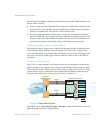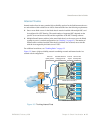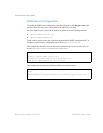
SmartConnect User’s Guide
36
Chapter 3: Switch Virtualization BMD00082, February 2009
In Figure 3-C, the two external trunks provide aggregation to the exterior network, and also
high-availability in case any single uplink cable, external port, switch module, or blade chassis
fails. On the service side of the network, each server includes two NICs which are automati-
cally connected to each of the switch modules within its blade chassis. Both internal switch
ports leading to each specific server are trunked together, despite belonging to different
switches in the stack. Each server is configured for NIC Teaming so that if either NIC or
switch module fails, the connection to the other switch is maintained using the same server IP
address.
Alternate configurations are possible. Internal trunks do not require that trunked ports belong
to the same VSG. Also, internal trunks may include multiple ports form any specific switch
(individually or as part of the stack).
By default, all internal ports are excluded from trunks. To assign internal ports to trunks, see
“Internal Trunk ID” on page 102.
IGMP Snooping
IGMP Snooping allows the switch to forward multicast traffic only to those ports that request
it. IGMP Snooping prevents multicast traffic from being flooded to all ports. The switch learns
which server hosts are interested in receiving multicast traffic, and forwards it only to ports
connected to those servers.
By default, the switch floods unregistered IP multicast (IPMC) packets to all ports.
On the BBI, choose Virtual Switch Groups > Settings to enable IGMP Snooping for the
desired VSG. The default value for all VSGs is enabled.


















